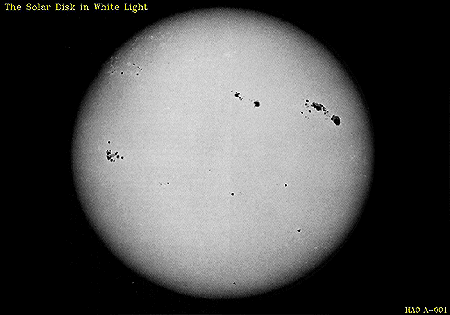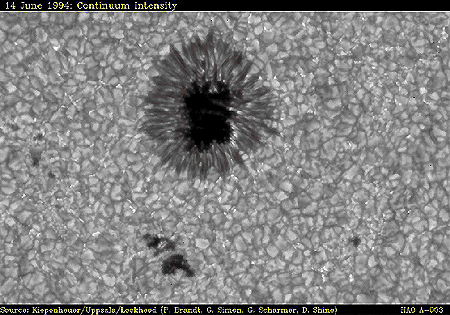The Sun's "Effective" Surface

The core, the radiation and the convection zones make up the interior of
the Sun, all of which is invisible to conventional means of observation.
Much like earth scientists study the interior of the earth by
measuring different vibrations, solar scientists are able to study the
interior of the Sun using its natural osciallations. This new field of solar
study is known as helioseismology.
 The exterior of the Sun is comprised of the surface and the atmosphere,
both of which can be studied using an array of telescopes and radiation
detectors. The photosphere is called the apparent
surface of the Sun.
Because the Sun is completely made of gas there is no hard surface like
there is on earth. Nonetheless, when we look at the Sun there is a
depth past which the gas begins to get so dense that we can not see
through it. We term the region where this happens the apparent
surface, or the photosphere. The photosphere is the disk you see
in the sky when you look at the Sun through a filtered telescope or as a
projection on a piece of paper. You should never look at the Sun directly,
it can cause blindness.
The exterior of the Sun is comprised of the surface and the atmosphere,
both of which can be studied using an array of telescopes and radiation
detectors. The photosphere is called the apparent
surface of the Sun.
Because the Sun is completely made of gas there is no hard surface like
there is on earth. Nonetheless, when we look at the Sun there is a
depth past which the gas begins to get so dense that we can not see
through it. We term the region where this happens the apparent
surface, or the photosphere. The photosphere is the disk you see
in the sky when you look at the Sun through a filtered telescope or as a
projection on a piece of paper. You should never look at the Sun directly,
it can cause blindness.
 When you look at the Sun with a filtered telescope you can see evidence in
the photosphere of the convective bubbles in the convection zone below. The
continuous rising and falling of hot and cool bubbles produces a pattern on
the surface of the Sun that is referred to as granulation. Shown here is an
image of granulation around a Sunspot in the photosphere.
When you look at the Sun with a filtered telescope you can see evidence in
the photosphere of the convective bubbles in the convection zone below. The
continuous rising and falling of hot and cool bubbles produces a pattern on
the surface of the Sun that is referred to as granulation. Shown here is an
image of granulation around a Sunspot in the photosphere.
Energy is transported through the photosphere once again by radiation.
Although the temperature of the photosphere is cool, about 5800 degrees
Kelvin, the gas is thin enough that the atoms absorb and release energy.
In fact, most of the light that we receive from the Sun on earth is energy
that was released by atoms in the photosphere (which literally means
sphere of light). It
takes light from the Sun just over eight minutes to reach the earth.

Sunspots
Structure Menu
 The exterior of the Sun is comprised of the surface and the atmosphere,
both of which can be studied using an array of telescopes and radiation
detectors. The photosphere is called the apparent
surface of the Sun.
Because the Sun is completely made of gas there is no hard surface like
there is on earth. Nonetheless, when we look at the Sun there is a
depth past which the gas begins to get so dense that we can not see
through it. We term the region where this happens the apparent
surface, or the photosphere. The photosphere is the disk you see
in the sky when you look at the Sun through a filtered telescope or as a
projection on a piece of paper. You should never look at the Sun directly,
it can cause blindness.
The exterior of the Sun is comprised of the surface and the atmosphere,
both of which can be studied using an array of telescopes and radiation
detectors. The photosphere is called the apparent
surface of the Sun.
Because the Sun is completely made of gas there is no hard surface like
there is on earth. Nonetheless, when we look at the Sun there is a
depth past which the gas begins to get so dense that we can not see
through it. We term the region where this happens the apparent
surface, or the photosphere. The photosphere is the disk you see
in the sky when you look at the Sun through a filtered telescope or as a
projection on a piece of paper. You should never look at the Sun directly,
it can cause blindness. 
